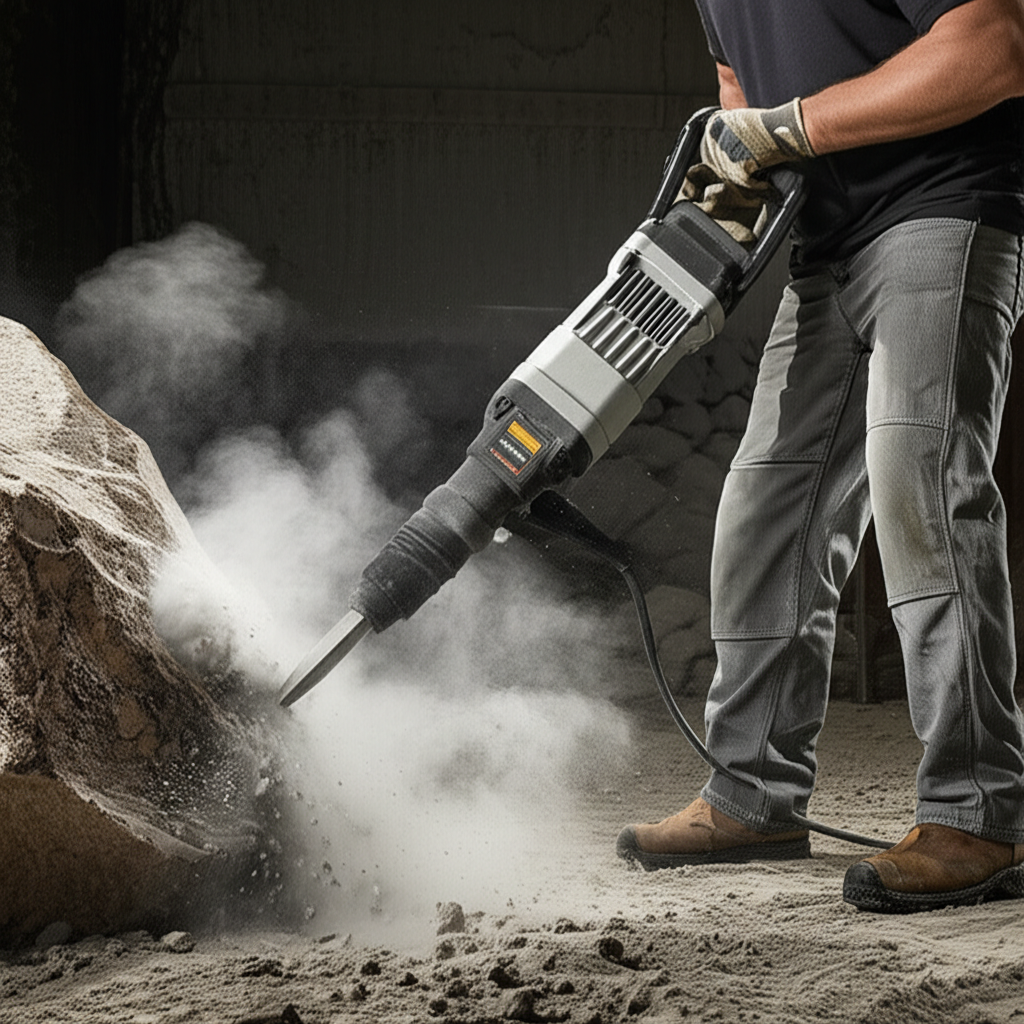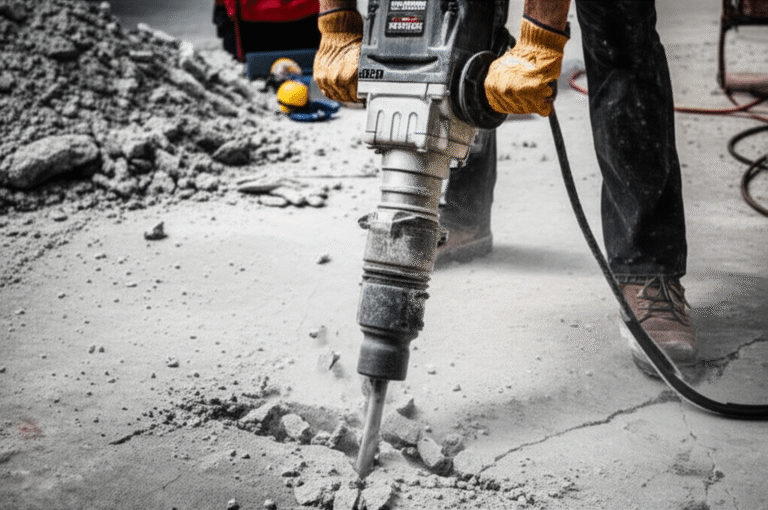How to Use a Jackhammer on Rock: Proven Power
Summary: Master using a jackhammer on rock with confidence! This guide breaks down safe operation, proper technique, and essential gear for breaking up tough materials efficiently. Learn to control the power for successful DIY demolition and excavation.
Tackling Tough Rock: Your Guide to Jackhammer Mastery
Got a stubborn rock formation blocking your path? Or maybe you’re prepping a foundation and hit something harder than expected? Breaking up solid rock can feel daunting, especially if you’re new to demolition tools. It’s easy to feel a bit intimidated by the sheer power of a jackhammer. But don’t worry! With the right knowledge and a bit of practice, you can safely and effectively break through even the toughest rock.
This guide is here to demystify the process. We’ll walk you through everything you need to know, from picking the right gear to handling the jackhammer like a pro. Get ready to transform that rock obstacle into manageable pieces!
Understanding Your Jackhammer
Before we dive into the “how,” let’s get acquainted with your new powerful friend. Jackhammers, also known as pavement breakers, are pneumatic (air-powered) or electric tools designed to break up hard surfaces like concrete, asphalt, and, yes, rock. They work by delivering rapid, high-impact blows through a chisel bit.
There are a few main types you might encounter:
- Pneumatic Jackhammers: These are the classic, powerful workhorses. They require an air compressor to operate, which means you’ll need to manage an extra piece of equipment and hoses. They’re great for heavy-duty, prolonged use.
- Electric Jackhammers: More common for DIYers and smaller jobs, these plug into a power source. They are generally lighter and easier to manage but might not have the same raw power as their pneumatic counterparts for extremely hard rock.
- Hydraulic Jackhammers: Less common for typical DIY projects, these are used with hydraulic power packs and are typically found on larger construction sites.
For breaking rock, you’ll generally want a more powerful model, whether that’s a robust electric unit or a pneumatic one. The key is consistent, forceful impact.
Essential Gear: Safety First, Always!
Using a jackhammer is not a task to take lightly. Safety is paramount. Here’s the essential gear you’ll need to protect yourself:
- Safety Glasses or Goggles: Absolutely non-negotiable. Flying debris is a serious hazard.
- Hearing Protection: Jackhammers are LOUD. Earplugs or earmuffs are a must to prevent hearing damage. Check out the NIOSH guidelines on noise and hearing loss prevention for more information.
- Heavy-Duty Gloves: Protect your hands from vibration, blisters, and sharp edges.
- Steel-Toed Boots: Essential for protecting your feet from dropped tools or heavy materials.
- Durable Work Clothes: Long pants and long-sleeved shirts made of sturdy material will protect your skin.
- Dust Mask or Respirator: Especially important when breaking rock, as it can create a lot of fine dust. A P100 respirator is recommended for silica dust.
Don’t skimp on safety gear. It’s your first line of defense against injury.
Choosing the Right Jackhammer Bit
The bit is the business end of your jackhammer, and picking the right one makes all the difference when tackling rock. The two most common types for breaking hard materials are:
| Bit Type | Description | Best For |
|---|---|---|
| Point Chisel (or Moil Point) | A sharp, pointed tip. | Penetrating and shattering hard, dense materials like rock and very hard concrete. It’s your go-to for initial breaking and fracturing. |
| Flat Chisel (or Pavement Breaker) | A wide, flat edge. | Breaking up slabs, pavement, and removing material once it’s been fractured. It’s good for clearing debris and making wider breaks. |
For breaking solid rock, you’ll almost always want to start with a point chisel. Its concentrated force is designed to crack and fracture the material.
Step-by-Step: How to Use a Jackhammer on Rock
Alright, you’ve got your gear, your jackhammer, and the right bit. Let’s get to work! Follow these steps for safe and effective rock breaking:
Step 1: Prepare the Work Area

Clear the area around the rock. Remove any loose debris, plants, or obstacles. Ensure you have stable footing. If you’re working near structures or utilities, double-check for underground lines. You can often find utility line maps from your local municipality or by calling 811 before you dig.
Step 2: Mount the Jackhammer Bit
With the jackhammer unplugged or disconnected from the air supply, insert the point chisel bit into the tool holder. Most jackhammers have a retaining system (like a collar or spring clip) to keep the bit in place. Ensure it’s seated firmly and locked.
Step 3: Position Yourself for Stability
Stand with your feet shoulder-width apart. Get a firm, balanced stance. The jackhammer will vibrate and push back, so a solid base is crucial. Don’t stand directly over the bit; position yourself slightly to the side.
Step 4: Start the Jackhammer
For electric models, plug it in and squeeze the trigger. For pneumatic models, ensure the air hose is connected and the air valve is open. The bit will start to hammer. Let the tool do the work; don’t force it.
Step 5: Apply Gentle Downward Pressure
Once the jackhammer is running, gently press the handles down towards the rock. You don’t need to lean your entire body weight onto it. The tool’s percussive action will do the heavy lifting. Let the hammer’s blows do the breaking.
Step 6: Find the “Sweet Spot”
Rock doesn’t break uniformly. You’ll need to experiment a bit to find the best spots to strike. Start near an edge or a natural crack if possible. Aim for areas where the rock seems weaker or has existing fractures.
Step 7: Work in a Pattern
Once you find a good spot, let the jackhammer hammer away. After a few seconds, you should see cracks forming. Move the bit slightly to widen these cracks or to a new spot nearby to continue breaking. Work in a systematic way, creating a pattern of breaks rather than just randomly hitting the rock.
Step 8: Control the Kickback
Jackhammers have significant recoil. Use your legs and core to absorb the vibration and pushback. Keep your grip firm but not overly tight. If the tool feels like it’s getting away from you, ease up on the pressure or reposition yourself.
Step 9: Clear Debris Regularly
As you break the rock, debris will accumulate. Use a shovel or broom to clear away smaller pieces and dust. This helps you see where you’re working and prevents the bit from getting bogged down.
Step 10: Take Breaks
Jackhammering is physically demanding. Take regular breaks to rest your hands and body. This also gives you a chance to reassess your progress and plan your next moves.
Tips for Efficient Rock Breaking
Maximizing your efficiency means breaking rock faster and with less effort. Here are some pro tips:
- Start with Existing Cracks: If the rock has any natural fissures or cracks, start there. It’s much easier to widen an existing break than to start from scratch.
- Vary Your Angle: Don’t just hit the rock straight on. Try angling the point chisel slightly to pry and fracture the rock.
- Listen to the Tool: A jackhammer will sound different when it’s biting into rock versus hitting loose dirt or empty air. Learn to recognize these sounds.
- Don’t Overwork a Spot: If you’ve been hitting one spot for a while and it’s not breaking, move slightly. Sometimes a different angle or location is more effective.
- Teamwork (If Possible): If you have a helper, one person can operate the jackhammer while the other clears debris and directs.
- Consider the Rock Type: Different types of rock have different strengths. Sedimentary rocks might fracture more easily than igneous rocks like granite. Adjust your technique accordingly. For very hard, dense rock, you might need a more powerful machine or more patience.
When to Call a Professional
While jackhammers are powerful DIY tools, there are times when it’s best to leave the job to the pros:
- Very Large Rock Formations: If you’re dealing with massive boulders or extensive bedrock, the scale might be beyond a typical DIY jackhammer.
- Uncertainty About Utilities: If you suspect buried utilities and can’t get clear information, it’s safer to hire professionals who can perform precise digging or utility locating.
- Limited Experience with Heavy Equipment: If you’re uncomfortable with the power and vibration of a jackhammer, or if you’ve never operated heavy machinery before, professional help is a wise choice.
- Job Safety Concerns: If the work area is unstable, has steep slopes, or presents other significant safety hazards, a professional crew will have the expertise and equipment to handle it safely.
For more information on when to hire a professional for excavation or demolition, resources like OSHA’s excavation safety guidelines can provide context on the risks involved.
Frequently Asked Questions (FAQ)
- Q1: Can I use a jackhammer on any type of rock?
- You can use a jackhammer on most types of rock, but its effectiveness depends on the rock’s hardness and your jackhammer’s power. Very dense or large rock formations may require more time, a more powerful tool, or professional assistance.
- Q2: How long does it take to break up rock with a jackhammer?
- This varies greatly! It depends on the size and type of rock, the power of your jackhammer, the type of bit you’re using, and your technique. Expect it to take longer than breaking concrete, especially for harder rocks.
- Q3: What’s the difference between a point chisel and a flat chisel for rock?
- A point chisel has a sharp tip designed for penetrating and fracturing hard materials like rock. A flat chisel has a wider edge, better for breaking up slabs or clearing debris once the material is already fractured.
- Q4: How do I control the vibration and kickback?
- Maintain a firm, balanced stance with your feet shoulder-width apart. Use your legs and core to absorb the vibration. Keep a firm grip on the handles but avoid clenching too tightly. Let the tool’s weight and power do the work; don’t force it excessively.
- Q5: Do I need an air compressor for a jackhammer?
- Only if you are using a pneumatic jackhammer. Electric jackhammers plug directly into a power outlet and do not require an air compressor.
- Q6: What safety precautions are most important when using a jackhammer on rock?
- The most critical precautions are wearing appropriate personal protective equipment (PPE): safety glasses, hearing protection, heavy-duty gloves, steel-toed boots, and a dust mask or respirator. Ensure you have stable footing and are aware of your surroundings.
Conclusion: You’ve Got This!
Breaking up rock with a jackhammer might seem like a Herculean task, but with the right preparation and technique, it’s absolutely achievable. Remember to prioritize safety above all else by wearing your PPE. Choose the right bit – the point chisel is your best friend for rock. Maintain a stable stance, let the tool do the work, and be patient as you find the best spots to fracture the material.
You’ve learned about the tools, the gear, and the step-by-step process. Now, go forth and conquer that rock! With practice, you’ll gain confidence and efficiency, making your DIY projects much smoother. Happy breaking!
